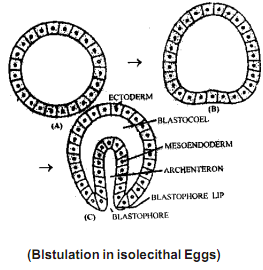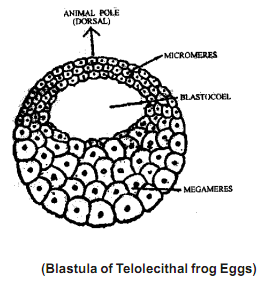TYPES OF BLASTULA -
Blastulas are of following type -



1. STEREOBLASTULA -
The blastocoel is very small. It's blastomere are less in number but large in size.
It is formed as a result of spiral cleavage. eg. Neries and some molluscs.
2. COELOBLASTULA -
The blastula of echinoderm and amphioxis is called coeloblastula.
It is formed through complete holoblastic cleavage. The blastoderm is formed of a single layer of cells.
Its blastocoel is filled wiht mucopolysaccaharide. In microlecithal egg blastocoel is centric.
In megalecithal egg blastocoel is excentric, eg. Some animal of echinodermes and amphioxis.
3. PERIBLASTULA OR SUPERFICIAL BLASTULA -
It is formed as a result of superficial cleavage. The blastocoel is absent.
There is a single layer of blastomeres around the uncleaved yolky part, eg. Insect.
4. DISCOBLASTULA -
It is formed as a result of discoidal cleavage. The blastocoel is small & it is called as subgerminal space. It is situated below the blastoderm, eg. Boney fishes, reptile, birds & prototherian mammals.

5. AMPHIBLASTULA -
It is formed of two types of structurally different blastomeres.
Example, in sycon the anterior half fo blastula is formed of flagellated cells while the posterior half is formed of large rounded granular cells on in amphibians where the two types of cells are micromeres and macromeres.
eg. Amphibians.
6. BLASTOCYST -
It is formed in mammals as a result of holoblastic cleavage.
Outer cells are called as trophoblasts or cells of Rauber. They form a trophoderm. This layer get attached to the uterine wall.
Inner cells form the embryo & are called as inner cell mass.
eg. Human beings.
